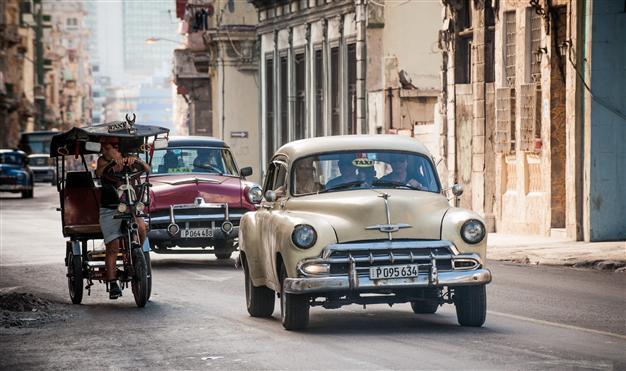New life begins for Cuba’s classic cars
HAVANA - The Associated Press

Old American cars are seen in a street of Havana, on December 19, 2014. AFP Photo / Yamil Lage
The half-century-old embargo on most U.S. exports has turned Cubans into some of the most inventive mechanics in the world, technicians capable of engineering feats long lost to the modern world of electronic ignitions and computerized engine calibration.President Barack Obama’s announcement that he is loosening the embargo through executive action has Cubans dreaming of an end to the era of cannibalizing train springs for suspensions and cutting tire patches by hand. One of the measures announced by Obama last week would allow U.S. exports to Cuba’s small class of private business owners, which includes thousands of mechanics and taxi drivers who shuttle both Cubans in battered sedans for about 50 cents a ride and tourists in shiny, restored vintage vehicles for $25 an hour.
While the details of Obama’s reforms remain uncertain, Cubans are hopeful that their publication in the coming weeks will be the announcement of the end of a five-decade drought of cars and parts.
“Maybe it will be possible to get parts faster, at better prices,” said a hopeful Raul Arabi, 58, who spoke with The Associated Press while seated behind the wheel of a cherry-red 1952 Chevy convertible that still runs on its original 6-cylinder engine. “If they opened a specific store for this, even better.”
Cuba long restricted car ownership almost entirely to prominent bureaucrats, high achievers in their fields and professionals who completed government service abroad. That limit was dropped last year but replaced by markups drove prices as high as $262,000 for a Peugeot listed for the equivalent of about $53,000 outside Cuba. That leaves classic cars as still one of the only options for Cubans needed private transportation for themselves or a business, although prices around $20,000 for old cars mean buyers on the island often need help for the purchase from relatives abroad.
With so much invested in their cars, new engines, hoods, fenders and transmissions is a dream for the owners of what were once known as “Humphrey Bogarts,” and remain a fixture of the landscape.
“It’s pretty complicated,” said Dairo Tio, 27. “The government won’t sell you glass for these old cars. They won’t sell replacement parts for these old cars. Everything is made by hand.”
A few years ago, the only way Tio could get new tires for his car was to rely on the generosity of a relative who brought some back from Venezuela.
In the meantime, necessity will drive invention when it comes to maintaining the thousands of classic cars that fill Cuba’s cities and countryside, many used for daily needs and commutes, others transporting curious tourists soaking up the nostalgia; newlyweds; or young girls celebrating their “quinceaneras,” - traditional 15th-birthday celebrations.
“When the material doesn’t exist, one has to invent it,” said a mechanic who agreed to reveal some of his secrets to the AP on the condition that he not be identified because he feared possible repercussions.
Suspension systems are among the most complicated to repair, simply because there are no parts available. But he noted that unused trains have similar springs that support a lot of weight, making them ideal for classic cars.
Train coil springs are smaller than those of the cars, but the mechanic described how they could be stretched with a manual press until they are the necessary height.
“We fix everything, all the time,” he said proudly.
















